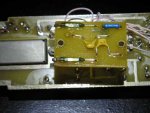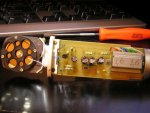Dear ladies and gentlemen,
Our company - Open joint-stock company Oktava (OAO Oktava) - manufactures and sells audio equipment since 1936.
Since 1950, OAO Oktava has been manufacturing and selling professional studio microphones and in 1989 it started to do that under the current trademark "Oktava".
Since then the trademark "Oktava" and a high quality of our microphones have gained popularity all over the world, which is confirmed by large demand for our products.
Unfortunately, a significant number of poor-quality counterfeit Oktava microphones have recently flooded the U.S. and European markets. According to our sources, the above mentioned copies of our products are produced in China on order from a UK firm Oktava Limited(A&F McKay).
The Oktava Limited(A&F McKay)’s allegations that the microphones produced by OAO Oktava have not been developed by OAO Oktava, are false. The OAO Oktava microphones, in particular the MK-012 and MK-219, have been produced by OAO Oktava since the 1980s, and their predecessors were the models MK-18, MK-011, produced in the 60s-70s. Oktava Limited(A&F McKay)’s statement that the design of microphones was developed and/or is an intellectual property of Oktava Limited(A&F McKay), has no foundation since that firm was established much later.
We also would like to point out, that at some point Oktava Limited(A&F McKay) was a distributor of the microphones produced by OAO Oktava in Tula, Russia, the microphones of the same models and modifications that are still being produced by OAO Oktava. The copies of those very microphones are now made in China. In 2004 Oktava Limited(A&F McKay) lost its distributor’s rights because it unlawfully used our trademark “Oktava” and violated numerous contract terms. This fact confirms that Oktava Limited(A&F McKay) cannot be a developer of the above-mentioned microphones and the owner of any rights to their design and technical know-how.
No less convincing argument confirming that Oktava microphones are developed and designed in Tula/Russia, is the fact, that during the last two years our company developed and put into series a number of new microphones: MKL-5000, MKL- 100,
MK-101,
MK-102,
MK-105,
ML-53 and others.
OAO Oktava thereby declares that it has no connection to the copies of Oktava products produced in China or in any other part of the world. OAO Oktava did not grant Oktava Limited(A&F McKay) any rights to manufacture copies of its products or use its trademark. OAO Oktava is not responsible for the quality of copies made in China or in any other part of the world. Microphones or any other products not produced by OAO Oktava, Tula, Russia, do not have the OAO Oktava’s guarantee and will not be serviced by OAO Oktava.
The original microphones, currently produced by OAO Oktava can be identified and distinguished from the copies made in China or in any other country according to the following characteristics:
The original Oktava microphones produced in Tula, Russia are supplied with a passport/manual and individual response curves charts. The counterfeit copies produced in China are supplied without any documents.
The original Oktava microphones produced in Tula, Russia are supplied with -10dB pads. The counterfeit copies produced in China are supplied without -10dB pads.
The original Oktava microphones produced in Tula, Russia are supplied with original metal holder. The counterfeit copies produced in China are supplied with a cheap plastic holder, meant for microphones with a smaller diameter.
Every original microphone, produced by OAO Oktava has its own serial number. The counterfeit copies produced in China have no serial numbers.
Contact elements of the original MK-012 produced in Tula, Russia are silver-sputtered for protection against oxidation. The counterfeit copies produced in China have red brazen contact-pins without any protective coverage, which leads to quick oxidation and loss of sound quality.
The bonding area of the original microphones produced in Tula, Russia has a dimple for effective contact. The counterfeit copies produced in China have no contact dimple.
If you would like to get more up-to-date information about the differences between original and counterfeit microphones, visit the following link:
http://oktava.tula.net/fake/
OAO Oktava would like to point out that the manufacturers of counterfeit copies can try to create an impression that microphones made and sold by them are made in Russia. For example, according to our sources, the counterfeit copies of our products could soon be supplied with -10dB pads and passports/manuals.
We would also like to point out that sellers of counterfeit copies of Oktava microphones often use the pictures of original Oktava microphones in the description of counterfeit copies. OAO Oktava highly recommends to inquire about the country of origin of the products before purchasing microphones.
OAO Oktava confirms the following official distributors of original Oktava products outside Russia:
USA: Recording Services Ltd.
www.oktavaUSA.com
Europe: Oktava-online (Einzelunternehmen Natalia Kuzmenko)
www.oktava-online.com
as well as the representatives of these firms.
In the near future, OAO Oktava will be glad to provide the comparative characteristics of the original microphones made in Russia, Tula and the counterfeit copies produced in China.
If you have any further questions please feel free to contact us. We will be glad to offer the documents confirming OAO Oktava’s authorship of the original Oktava microphones, currently on the market.
Best regards,
Gennady Ulyanov
General Director of OAO Oktava, Russia.





